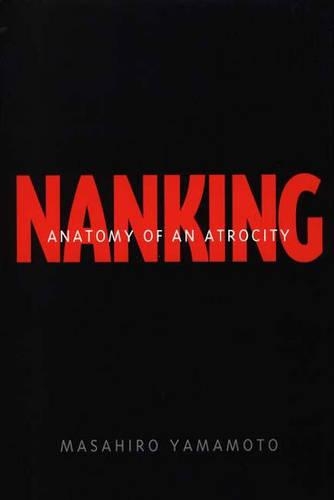
Nanking: Anatomy of an Atrocity
(Hardback)
Publishing Details
Nanking: Anatomy of an Atrocity
By (Author) Masahiro Yamamoto
Bloomsbury Publishing PLC
Praeger Publishers Inc
30th August 2000
United States
Classifications
Tertiary Education
Non Fiction
War and defence operations
War crimes
951.042
Physical Properties
Hardback
368
Width 156mm, Height 235mm
765g
Description
The December 1937 incident that has come to be known as the Rape of Nanking is, without doubt, a tragedy that will not soon be forgotten. While acknowledging that a tremendous loss of life occurred, this study challenges the current prevailing notion that the incident was a deliberate, planned effort on the part of the Japanese military and analyzes events to produce an accurate estimate of the scale of the atrocities. Drawing on Chinese, Japanese, and English sources, Yamamoto determines that what happened at Nanking were unfortunate atrocities of conventional war with precedents in both Eastern and Western military history. He concludes that post-war events such as the war crimes trials and the impact of the Holocaust in Europe affected public opinion regarding Nanking and led to a dramatic reinterpretation of events. The Rape of Nanking consisted of two distinct phases: the mass execution of prisoners of war (as well as conscription age men who appeared to be combatants) and the delinquent acts of individual soldiers. The first phase, which occurred immediately after Nanking's fall and which claimed most of the atrocity victims, was the result of the Japanese military's attempt to clear the city of Chinese soldiers thought to be in plain clothes. The second phase, which lasted approximately six weeks, was horrible, but resulted in a much smaller number of fatalities. It was characterized by numerous criminal acts, ranging from rape and murder to arson and theft, committed by unrestrained Japanese soldiers. The root cause for both phases was the Japanese military's bureaucratic inefficiency and command irresponsibility. While both Chinese and American contemporary sources initially attributed the incident to these causes, subsequent Japanese atrocities against both military and civilian Allied personnel during World War II and evidence presented at war crimes trials would come to reshape perceptions of the Nanking events as an Asian counterpart to the Nazi Holocaust.
Reviews
"The historical landscape is undergoing a curious change. A new genre has sprouted, [taking] the form of short books on dramatic events they focus on an incident, relate it as a story, and then follow its repercussions through the social order....They pose dizzying questions: How can we know what actually happened Where is the truth to be found among competing interpretations Many of the incidents concern the blackest aspects of the twentieth century. The massacre of defenseless civilians during their occupation of Nanking illustrates this tendency....Nanking: The Anatomy of an Atrocity by Masahiro Yamamoto shows how the debate about [these] events has continued to reverberate through Japanese society. Yamamoto attempted to arrive at an accurate assessment of the scale of the massacre....That estimate discredited revisionists, who claimed that virtually no atrocities had occurred, but it fell far short of the more standard view."-The New York Review of Books
[T]his is an excellent study...Yamamoto has affected scholarly assessments of the Sino-Japanese War.-The Journal of Asian Studies
[T]his work is a significant contribution. Yamamoto argues that without "clarification of the truth," there is "no way to determine in what way the Japanese...should be held responsible." His careful, dispassionate analysis of evidence, added to his refusal to embrace either the deniers or the outraged, may make us uncomfortable, but it does move us toward clarity.-The Historian
The historical landscape is undergoing a curious change. A new genre has sprouted, [taking] the form of short books on dramatic events they focus on an incident, relate it as a story, and then follow its repercussions through the social order....They pose dizzying questions: How can we know what actually happened Where is the truth to be found among competing interpretations Many of the incidents concern the blackest aspects of the twentieth century. The massacre of defenseless civilians during their occupation of Nanking illustrates this tendency....Nanking: The Anatomy of an Atrocity by Masahiro Yamamoto shows how the debate about [these] events has continued to reverberate through Japanese society. Yamamoto attempted to arrive at an accurate assessment of the scale of the massacre....That estimate discredited revisionists, who claimed that virtually no atrocities had occurred, but it fell far short of the more standard view.-The New York Review of Books
"This is an excellent study...Yamamoto has affected scholarly assessments of the Sino-Japanese War."-The Journal of Asian Studies
"This work is a significant contribution. Yamamoto argues that without "clarification of the truth," there is "no way to determine in what way the Japanese...should be held responsible." His careful, dispassionate analysis of evidence, added to his refusal to embrace either the deniers or the outraged, may make us uncomfortable, but it does move us toward clarity."-The Historian
"[T]his is an excellent study...Yamamoto has affected scholarly assessments of the Sino-Japanese War."-The Journal of Asian Studies
"[T]his work is a significant contribution. Yamamoto argues that without "clarification of the truth," there is "no way to determine in what way the Japanese...should be held responsible." His careful, dispassionate analysis of evidence, added to his refusal to embrace either the deniers or the outraged, may make us uncomfortable, but it does move us toward clarity."-The Historian
Author Bio
MASAHIRO YAMAMOTO is currently a Visiting Assistant Professor of Asian Studies at Randolph-Macon College in Ashland, Virginia. His specialty is military and naval history as well as Japanese History. He also teaches Japanese language.
